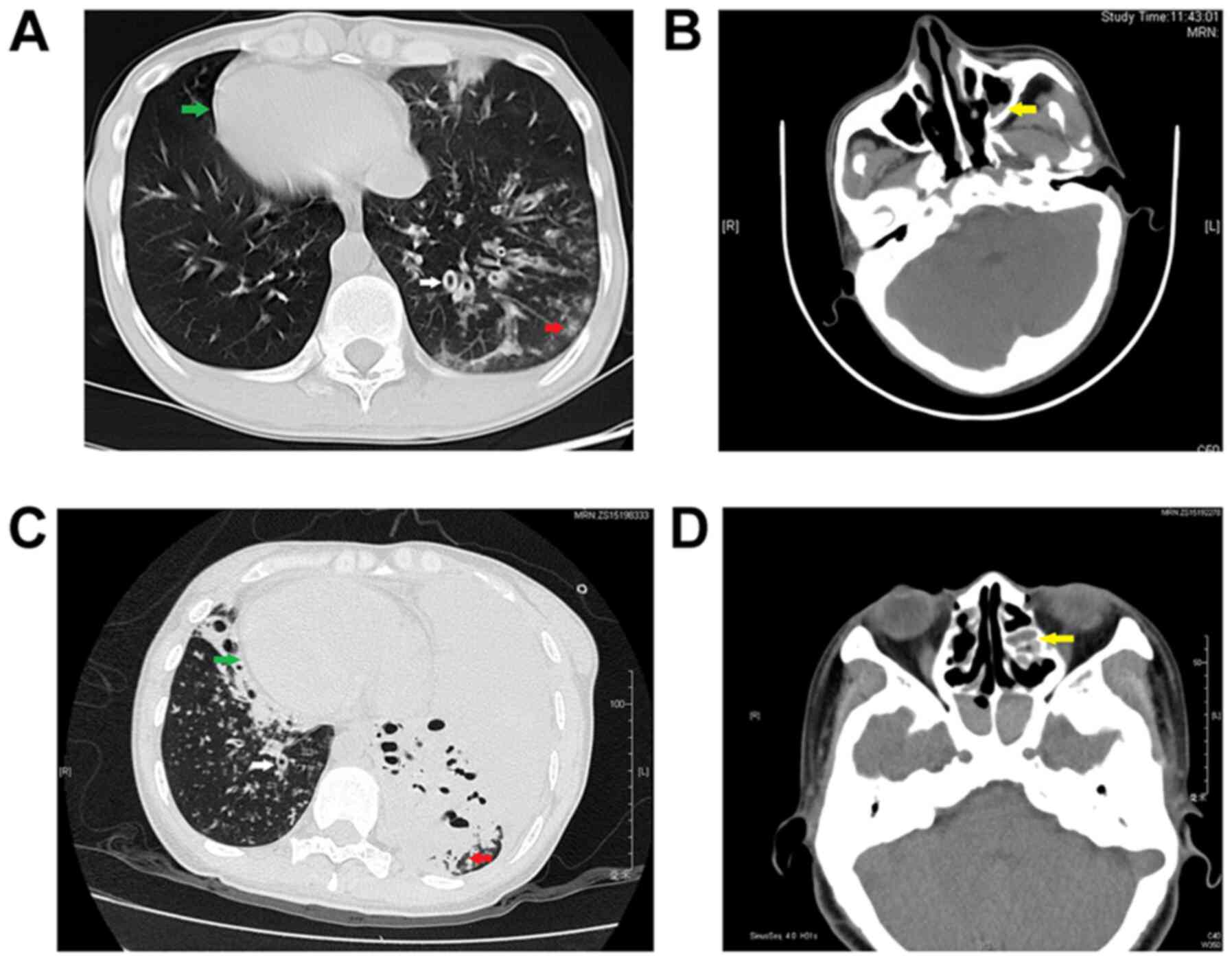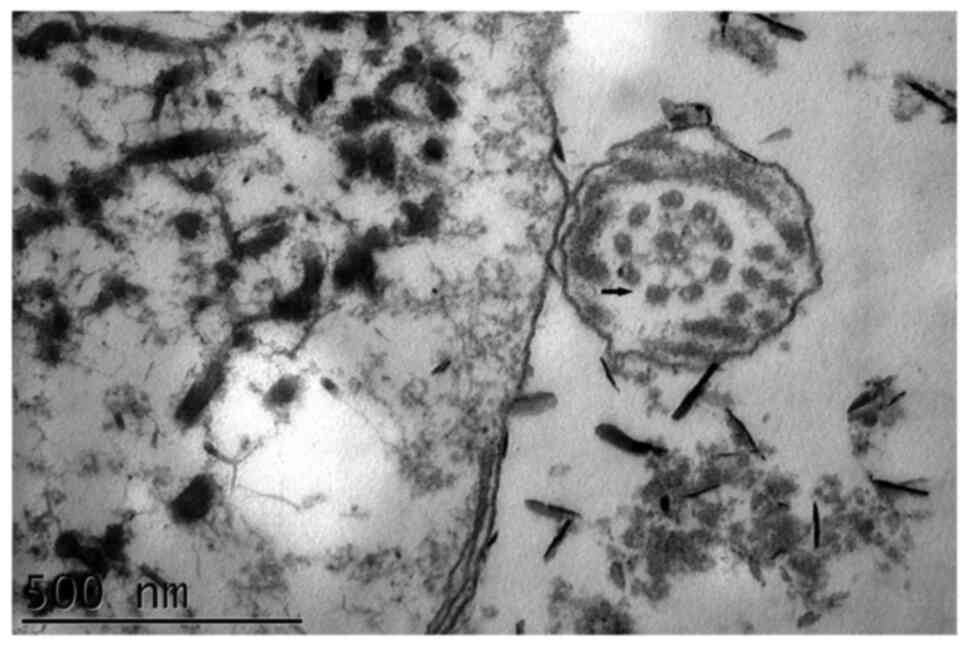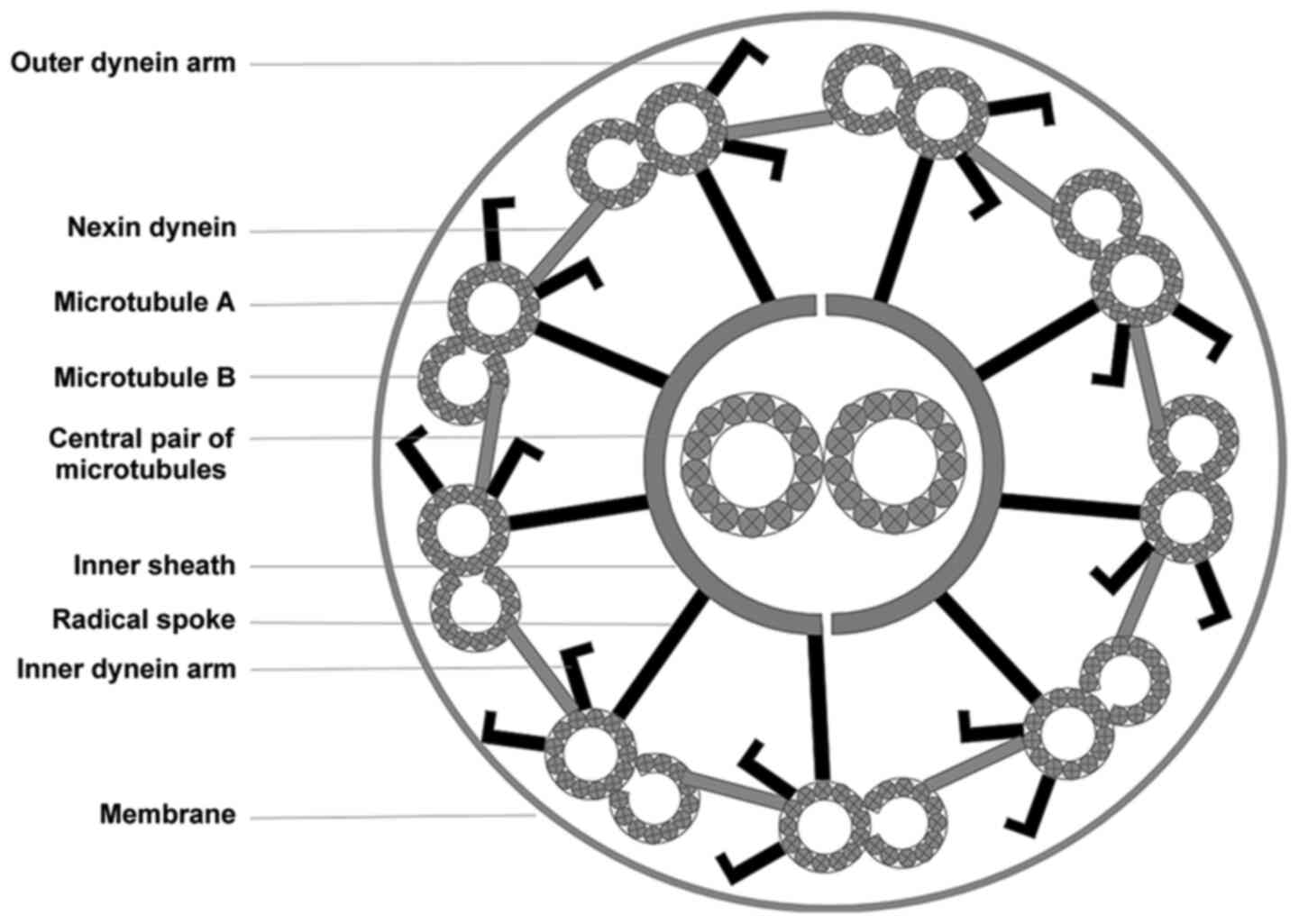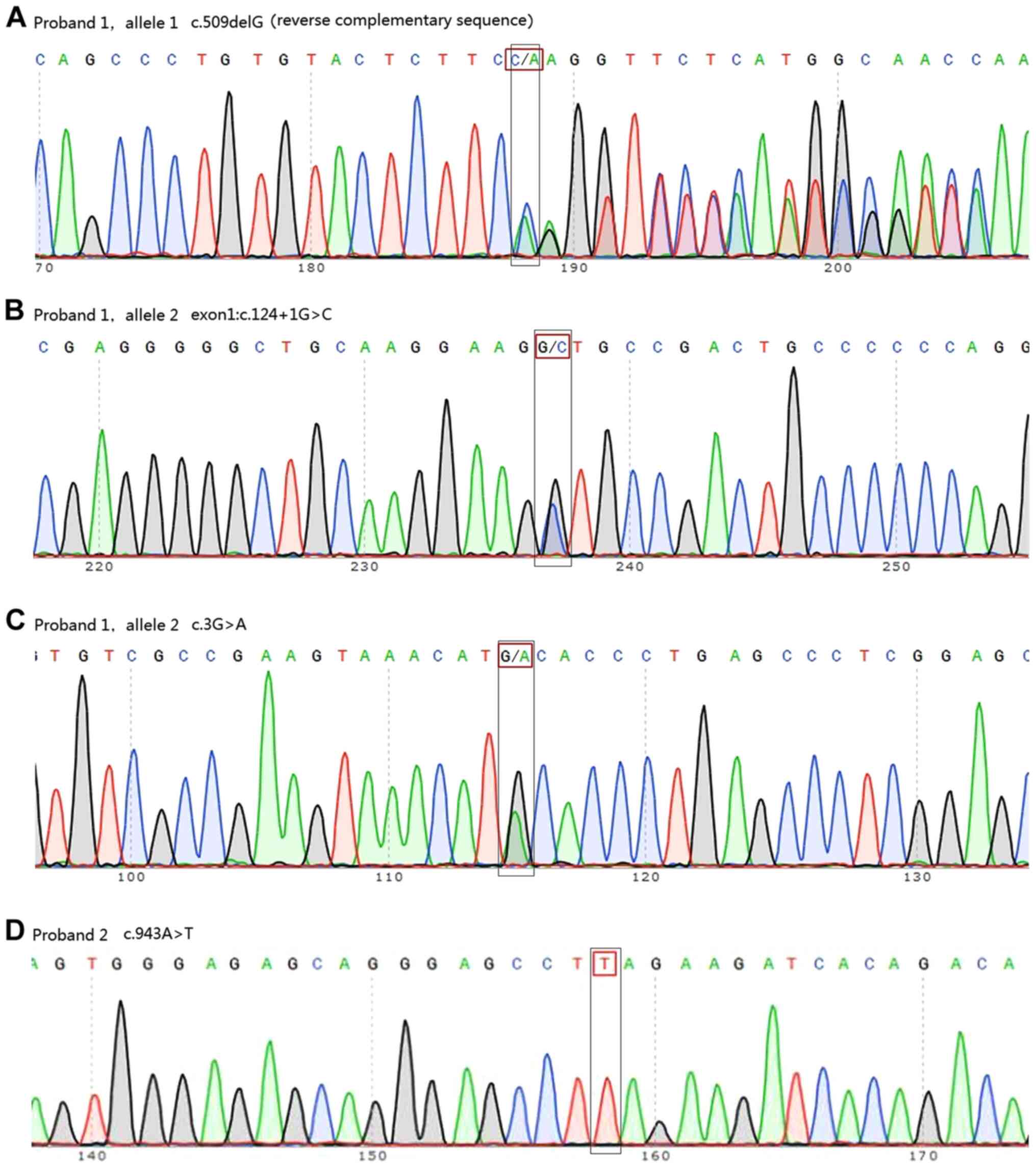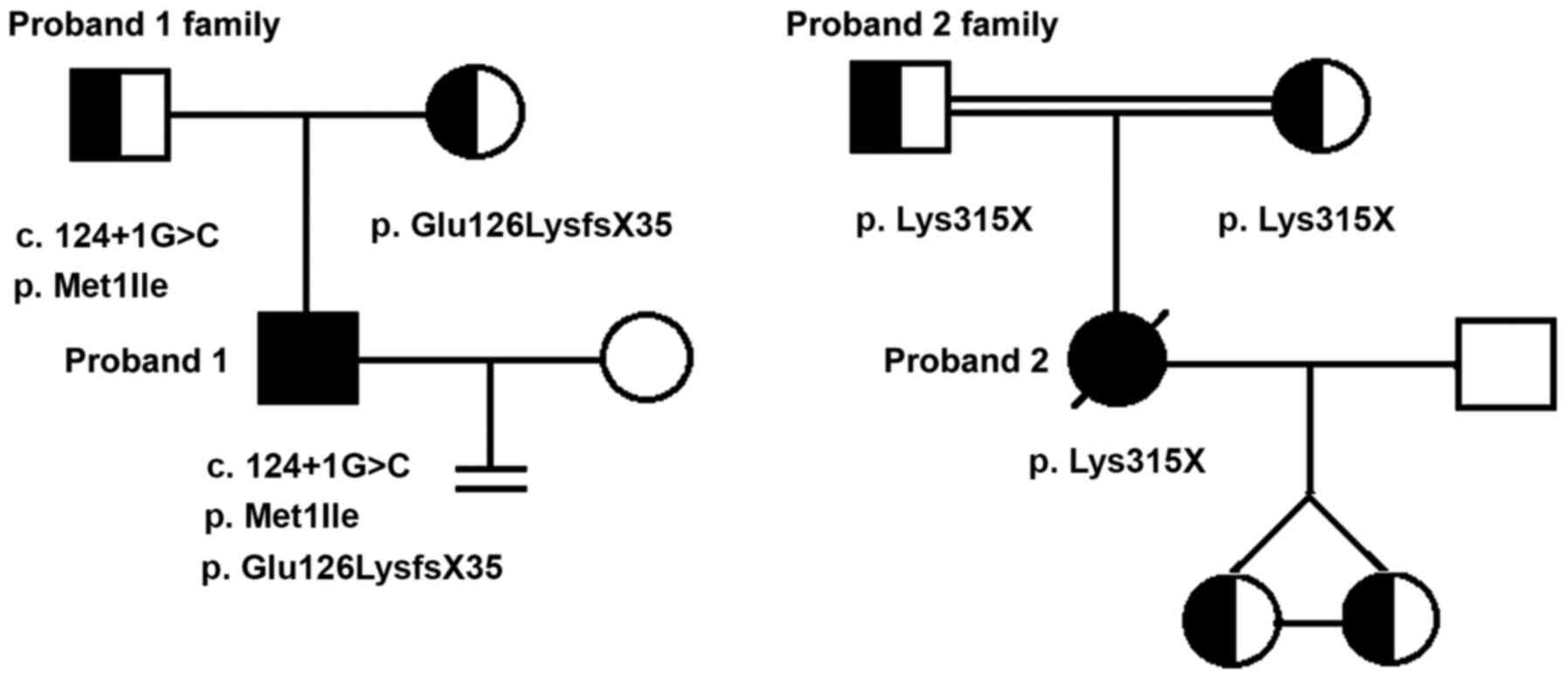|
1
|
Olm MA, Caldini EG and Mauad T: Diagnosis
of primary ciliary dyskinesia. J Bras Pneumol. 41:251–263. 2015.(In
English, Portuguese). View Article : Google Scholar : PubMed/NCBI
|
|
2
|
Frommer A, Hjeij R, Loges NT, Edelbusch C,
Jahnke C, Raidt J, Werner C, Wallmeier J, Große-Onnebrink J,
Olbrich H, et al: Immunofluorescence analysis and diagnosis of
primary ciliary dyskinesia with radial spoke defects. Am J Respir
Cell Mol Biol. 53:563–573. 2015. View Article : Google Scholar : PubMed/NCBI
|
|
3
|
Brown J and Witman G: Cilia and Diseases.
Bioscience. 64:1126–1137. 2014. View Article : Google Scholar : PubMed/NCBI
|
|
4
|
Cao Y, Shao C, Song Y, Bai C and He L:
Clinical analysis of patients with primary ciliary dyskinesia in
mainland China. Clin Respir J. 10:765–771. 2016. View Article : Google Scholar : PubMed/NCBI
|
|
5
|
Leigh MW, Horani A, Kinghorn B, O'Connor
MG, Zariwala MA and Knowles MR: Primary Ciliary Dyskinesia (PCD): A
genetic disorder of motile cilia. Transl Sci Rare Dis. 4:51–75.
2019.PubMed/NCBI
|
|
6
|
Loges NT, Olbrich H, Becker-Heck A,
Häffner K, Heer A, Reinhard C, Schmidts M, Kispert A, Zariwala MA,
Leigh MW, et al: Deletions and point mutations of LRRC50 cause
primary ciliary dyskinesia due to dynein arm defects. Am J Hum
Genet. 85:883–889. 2009. View Article : Google Scholar : PubMed/NCBI
|
|
7
|
Duquesnoy P, Escudier E, Vincensini L,
Freshour J, Bridoux AM, Coste A, Deschildre A, de Blic J, Legendre
M, Montantin G, et al: Loss-of-function mutations in the human
ortholog of Chlamydomonas reinhardtii ODA7 disrupt dynein arm
assembly and cause primary ciliary dyskinesia. Am J Hum Genet.
85:890–896. 2009. View Article : Google Scholar : PubMed/NCBI
|
|
8
|
Marshall CR, Scherer SW, Zariwala MA, Lau
L, Paton TA, Stockley T, Jobling RK, Ray PN, Knowles MR; FORGE
Canada Consortium, ; Hall DA, et al: Whole-exome sequencing and
targeted copy number analysis in primary ciliary dyskinesia. G3
(Bethesda). 5:1775–1781. 2015. View Article : Google Scholar : PubMed/NCBI
|
|
9
|
Desmet FO, Hamroun D, Lalande M,
Collod-Béroud G, Claustres M and Béroud C: Human Splicing Finder:
An online bioinformatics tool to predict splicing signals. Nucleic
Acids Res. 37:e672009. View Article : Google Scholar : PubMed/NCBI
|
|
10
|
Yeo G and Burge CB: Maximum entropy
modeling of short sequence motifs with applications to RNA splicing
signals. J Comput Biol. 11:377–394. 2004. View Article : Google Scholar : PubMed/NCBI
|
|
11
|
Kennedy MP, Omran H, Leigh MW, Dell S,
Morgan L, Molina PL, Robinson BV, Minnix SL, Olbrich H, Severin T,
et al: Congenital heart disease and other heterotaxic defects in a
large cohort of patients with primary ciliary dyskinesia.
Circulation. 115:2814–2821. 2007. View Article : Google Scholar : PubMed/NCBI
|
|
12
|
Satir P and Christensen ST: Overview of
structure and function of mammalian cilia. Annu Rev Physiol.
69:377–400. 2007. View Article : Google Scholar : PubMed/NCBI
|
|
13
|
Fliegauf M, Benzing T and Omran H: When
cilia go bad: Cilia defects and ciliopathies. Nat Rev Mol Cell
Biol. 8:880–893. 2007. View
Article : Google Scholar : PubMed/NCBI
|
|
14
|
Jorissen M, Willems T, Van der Schueren B,
Verbeken E and De Boeck K: Ultrastructural expression of primary
ciliary dyskinesia after ciliogenesis in culture. Acta
Otorhinolaryngol Belg. 54:343–356. 2000.PubMed/NCBI
|
|
15
|
Papon JF, Coste A, Roudot-Thoraval F,
Boucherat M, Roger G, Tamalet A, Vojtek AM, Amselem S and Escudier
E: A 20-year experience of electron microscopy in the diagnosis of
primary ciliary dyskinesia. Eur Respir J. 35:1057–1063. 2010.
View Article : Google Scholar : PubMed/NCBI
|
|
16
|
van Rooijen E, Giles RH, Voest EE, van
Rooijen C, Schulte-Merker S and van Eeden FJ: LRRC50, a conserved
ciliary protein implicated in polycystic kidney disease. J Am Soc
Nephrol. 19:1128–1138. 2008. View Article : Google Scholar : PubMed/NCBI
|
|
17
|
Hartill VL, Hoek G, Patel MP, Little R,
Watson CM, Berry IR, Shoemark A, Abdelmottaleb D, Parkes E,
Bacchelli C, et al: DNAAF1 links heart laterality with the AAA1
ATPase RUVBL1 and ciliary intraflflagellar transport. Hum Mol
Genet. 27:529–545. 2018. View Article : Google Scholar : PubMed/NCBI
|
|
18
|
Fliegauf M, Olbrich H, Horvath J,
Wildhaber JH, Zariwala MA, Kennedy M, Knowles MR and Omran H:
Mislocalization of DNAH5 and DNAH9 in respiratory cells from
patients with primary ciliary dyskinesia. Am J Respir Crit Care
Med. 171:1343–1349. 2005. View Article : Google Scholar : PubMed/NCBI
|
|
19
|
Ha S, Lindsay AM, Timms AE and Beier DR:
Mutations in DNAAF1 and LRRC48 cause hydrocephalus, laterality
defects, and sinusitis in mice. G3 (Bethesda). 6:2479–2487. 2016.
View Article : Google Scholar : PubMed/NCBI
|
|
20
|
Lobo LJ, Zariwala MA and Noone PG: Primary
ciliary dyskinesia. QJM. 107:691–699. 2014. View Article : Google Scholar : PubMed/NCBI
|
|
21
|
Omran H, Kobayashi D, Olbrich H, Tsukahara
T, Loges NT, Hagiwara H, Zhang Q, Leblond G, O'Toole E, Hara C, et
al: Ktu/PF13 is required for cytoplasmic pre-assembly of axonemal
dyneins. Nature. 456:611–616. 2008. View Article : Google Scholar : PubMed/NCBI
|
|
22
|
Sha Y, Ding L and Li P: Management of
primary ciliary dyskinesia/Kartagener's syndrome in infertile male
patients and current progress in defining the underlying genetic
mechanism. Asian J Androl. 16:101–106. 2014. View Article : Google Scholar : PubMed/NCBI
|
|
23
|
Lyons RA, Saridogan E and Djahanbakhch O:
The reproductive signifificance of human Fallopian tube cilia. Hum
Reprod Update. 12:363–372. 2006. View Article : Google Scholar : PubMed/NCBI
|
|
24
|
Raidt J, Werner C, Menchen T, Dougherty
GW, Olbrich H, Loges NT, Schmitz R, Pennekamp P and Omran H:
Ciliary function and motor protein composition of human fallopian
tubes. Hum Reprod. 30:2871–2880. 2015. View Article : Google Scholar : PubMed/NCBI
|
|
25
|
Miao C, Jiang Q, Li H, Zhang Q, Bai B, Bao
Y and Zhang T: Mutations in the motile cilia gene DNAAF1 are
associated with neural tube defects in humans. G3 (Bethesda).
6:3307–3316. 2016. View Article : Google Scholar : PubMed/NCBI
|















